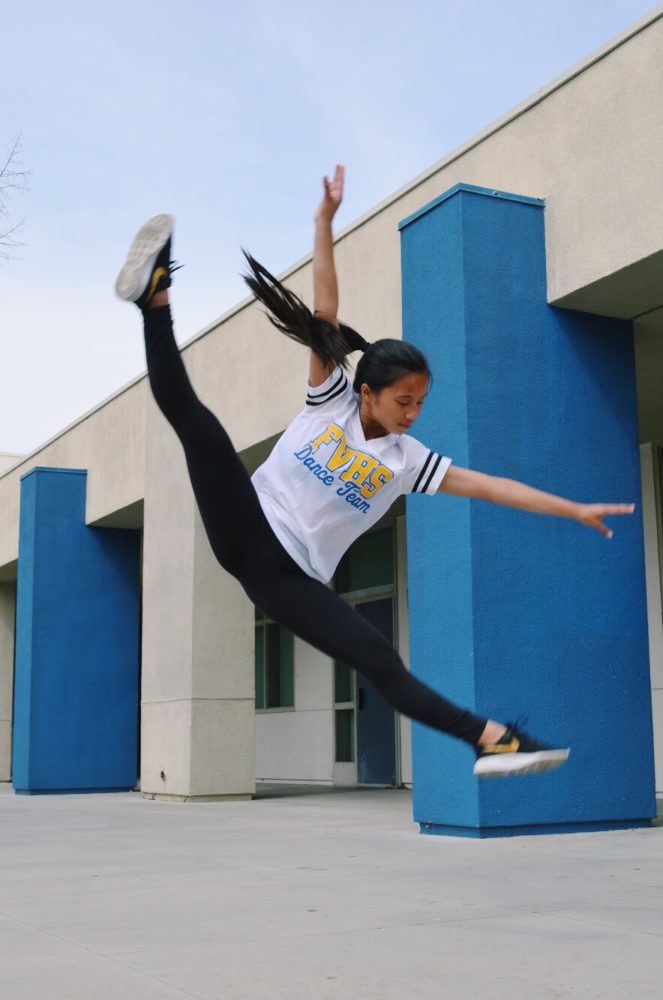
This story was published in the 2019 Red Magazine. Stop by room 306 for a copy.
By Elyssa Phan
Speaking with only a slight British accent that you can only catch if you talk to her after a while, it’s crazy to believe that we have an England transfer student walking among our high school hallways. Freshman Amour Sumagaysay, born and raised in England all the way up until the time she was 12 and moved to America, has been a natural star dancing on Fountain Valley High School Varsity team.
Sumagaysay began dancing when she was 3, starting out with ballet classes and then branching out to more styles later on. Her passion for competing soon followed when she was around 6 and she has been pursuing those two passions ever since (Sumagaysay dedicates up to 3 hours after school everyday currently). However, Sumagaysay is not your ordinary dancer. When she was 8, she was featured on a British dance TV show—it was well-recognizable enough that it was eventually discovered by her dance teammates without her even mentioning.
Meeting a student for the first time who was a) a transfer student from England, and b) who happens to be a talented dancer, as a writer, I could not help but ask her the most obvious question: Was there any difference between the dance scene in England and in America?
“[The dance competitions] are different… basically in England, the dance competitions that I did was that you would dance and they would call you back if you made the last round. It’s almost like an audition, you know? And then here, you perform once and then that’s it. If you messed up then it’s like ‘oh well you can do better the next one’ but over there, if you messed up then you can go out there again and give it more you know,” Sumagaysay points out.
However, dance competitions aren’t the only things done differently between the two countries. Piling up her schedule with challenging courses such as English Honors, Accelerated Biology, and Spanish 2, one would think Sumagaysay has been readily prepared for the All-American High School Life all her life. Although she admits the classes offered are generally the same, she does note that there are quite a number of differences between England’s school system and America’s.
“As a highschool student [in England], we have these things called GCSEs and they’re like the big tests of the high school and then we get to choose [electives]… I would be finishing school when I’m 16 and here is 18 so it’s weird. And also the teachers and the lifestyle is obviously different… American schools are really into sports, but over there in England they don’t do sports that much,” Sumagaysay said.
Like all of the movies and TV shows of British students suggest, the stereotype proves true after all: They do wear uniforms—from the blazers to the ties. However, I was curious to know what kind of stereotype British students have of us American high schoolers and whether or not it proves true.
“The big stereotype of all the mean girls and stuff? I don’t see people as mean here. But the thing is what I do see is like, you know how everyone is on cheer or in a different sport like basketball, or you know how they all have their close groups? It’s kind of weird to see they’re like in groups as well, you know?” Sumagaysay said.
In England, it’s harder to tell who’s into what because everyone is in a uniform. Here, Sumagaysay observes that sports teams wear their specific uniform on their game days and specific events.
Whether in England or in America, there’s one thing that remains the same: Amour Sumagaysay’s passion for dancing that hasn’t wavered since she was three.
“I would say that you should always have fun. Because if you don’t like what you’re doing and you just do it just because you wanna get out of PE or something, then there’s not really a point,” said Sumagaysay. Because while dancing, obviously there’s pressure, but you make memories and you got to live in the moment.”
This story was published in the 2019 Red Magazine. Stop by room 306 for a copy.





